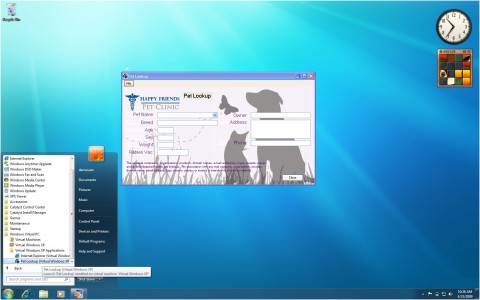
Microsoft has made enhancements to its upcoming Windows 7 operating system that will speed up applications on machines with Intel's multicore chips, resulting in better overall system performance and less power consumption.
Hardware hooks in Intel's new chips will help Windows 7 deliver performance gains when running applications like DVD playback compared to Windows Vista, the companies said in a joint press briefing on Tuesday. The improved performance is accompanied by more efficient power usage, as the OS makes better use of power management features included in Intel's latest chips.
Microsoft has designed the OS to scale application performance by intelligently breaking up tasks like video encoding for simultaneous execution over multiple cores and threads, the companies said. For example, a Microsoft engineer could render a high-resolution image 10 percent faster on a Windows 7 system with a quad-core processor that ran two threads per core, versus a system that ran one thread per core.
The performance improvement depends on the application and usage scenario, said Ruston Panabaker, principal program manager at Microsoft. Microsoft and Intel officials were unwilling to talk in general about overall OS performance improvement compared to Windows Vista or Windows XP. Windows 7 is due for release on Oct. 22.
Most Intel chips included in consumer PCs execute only one thread per core. However, Windows 7 users may see real performance boosts when Intel releases new laptop and desktop chips based on the Westmere microarchitecture that can execute two threads per core. The new chips -- respectively code-named Arrandale and Clarkdale for laptops and desktops -- will be in production in the fourth quarter this year. The chips will be manufactured using the advanced 32-nanometer process and could reach systems by early next year.
While improving system performance, the intelligent breakdown of tasks could also reduce power drawn by systems, said Mike Angiulo, general manager of the Windows planning and PC ecosystem. Clock speeds of each core can be reduced when tasks are distributed among cores, which makes a processor more power-efficient.
Microsoft has made some kernel changes in Windows 7 to improve the power management of cores on Intel's chips compared to previous operating systems. A demonstration showed the power drain during DVD playback on a battery-powered Windows 7 laptop of 15.63 watts, compared to a drain of 20.48 watts on a similar Windows Vista laptop. Such power savings could improve battery life of a laptop by hours, Panabaker said.
Microsoft also makes better use of a timer system that puts cores in Intel processors back into sleep mode when idle. Depending on usage, the OS can intelligently put different cores into different power states, and processors remain in idle mode for a longer period in Windows 7 compared to Windows Vista, Panabaker said.
Intel's Westmere chips will also feature new onboard instructions for AES (Advanced Encryption Standard), which gives hardware instructions to speed up encryption of data, said Mark Swearingen, director of Microsoft program office at Intel. Microsoft has added the AES instructions to the Windows API (application programming interface) so application developers can build programs using the feature.
One program that takes advantage of on-chip AES is BitLocker, a Windows 7 feature to encrypt data in a system. Typically disk encryption and AES-type functions have some CPU overhead and new instructions help to reduce that overhead, Swearingen said.
Another feature included in Windows 7 that takes advantage of Intel chips is XP Mode, an environment that allows users to run Windows XP-compatible programs. The technology uses Intel's on-chip virtualization technology, and it is particularly useful for small businesses that need a safety net to run legacy applications. This feature is also supported on AMD's AMD-V virtualization technology, which comes with most AMD chips.
Microsoft's Angiulo said the software maker took a different development approach during Windows 7 to better tune it to the latest hardware. Instead of delivering a beta of an OS with potential ideas like in the past, Microsoft tried to deliver an OS that was close to a complete version. The feedback from beta testers helped prioritize engineering ideas, which helped improve the OS with relation to system performance and power management.
It is also the first time Microsoft hasn't doubled system requirements for Windows with a new release, Angiulo said. The Windows XP to Windows Vista upgrade in 2007 required users to have faster processors and more memory, but Windows 7 can run on hardware from netbooks to servers, he said. The company also worked with other hardware and software partners to ensure compatible software and drivers were available at the launch of Windows 7.
For example, Windows 7 will support a new API called DirectX 11, which breaks up tasks over multiple CPUs and graphics processing units for better graphics and multimedia performance. The software giant is working with top graphics chip makers Nvidia and Advanced Micro Devices on those features.
Microsoft isn't the only company to make hardware-related improvements to boost OS performance. Apple has changed the basic architecture of its Mac OS X 10.6 OS, also known as Snow Leopard, by enhancements that allow the OS to divvy up tasks for simultaneous execution across multiple CPU and GPU cores.







0 comments:
Post a Comment